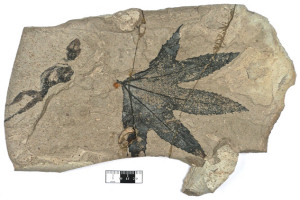Advanced Synchrotron Light Rays – Shed “Light” on Long Dead Lizards
A joint Anglo/American team of researchers led by scientists from the University of Manchester are using an extremely powerful light source to pick up tiny traces of chemical signatures and by doing so they are “shedding light” on fossils and making some exciting new discoveries.
University of Manchester
Many of the fossils held in museum and university collections were found in the 19th and 20th Centuries, these fossils may have been scientifically described and carefully studied, but scientists are now able to use technologies beyond the imaginations of their academic predecessors to explore fossil material and tease out new information from the ancient rocks. A team of scientists from the Palaeontology Research Group at Manchester University were able to collaborate with the engineers based at the Stanford University Synchrotron Radiation Lightsource (based in California, United States), and reveal new information on the fifty million year old fossil of a lizard.
The Stanford Synchrotron Radiation Lightsource
The Stanford Synchrotron Radiation Lightsource is one of the most sophisticated and powerful synchrotrons in the western world. The technology, enabling strong beams of electromagnetic radiation, produced by particle accelerators to bombard an object with intense light has been around for fifty years or so. This technology has a wide range of applications, from providing engineers with an ability to assess structural issues in new materials, to being used in medicine, physics and now to scan fossils looking for tiny traces of otherwise invisible elements.
This non-invasive and non-destructive technique has been used on a Palaeogene fossil of a lizard, which was originally thought to be just a moulted skin. However, the electromagnetic radiation scans found tiny traces of phosphorous where the teeth in the miniature jaws would have been. This proved that teeth had been present in the fossil and since no member of the Squamata (lizards and snakes) sheds their teeth as well as their skin when they moult, the fossil was re-described as a more complete specimen.
Fifty-million-year-old Lizard Fossil Used in the Study

Shedding light onto ancient creatures.
Picture credit: University of Manchester/Applied Physics
The Manchester University team of scientists, a collaboration from various faculties includes Dr Roy Wogelius and Dr Phil Manning, who has recently been in the United States working on the excavation of a number of Triceratops (dinosaur fossils). One application of this new technology could be the analysis of dinosaur fossils, preserved in coarse sandstone to detect the chemical signatures of feathers which otherwise would not have shown up under more conventional light studies and X-rays. This could help palaeontologists to understand more about the evolution of feathers and ultimately the relationship between Aves (birds) and the Dinosauria.
Detecting the Presence of Chemicals
Not only was the powerful synchrotron able to detect the presence of chemicals related to the teeth of the tiny lizard, but their chemical signatures and placement in the jaw corresponding to other general features such as the lizard’s relatively elongated snout enabled the scientists to establish more information about the family and genus this fifty million year old specimen might be related to.
Based on this study, the team have concluded that the fossil specimen has a close resemblance to shinisaurids (Chinese Crocodile Lizards), these are small, semi-aquatic lizards that can be found today in south-east Asia. The fossil specimen has been proposed as being an example of Bahndwivici ammoskius an extinct shinisaurid that lived in Wyoming during the Eocene Epoch.
For prehistoric animal themed merchandise including dinosaur toys and games: Everything Dinosaur.
Commenting on the research work carried out by the team, palaeontologist Dr Phil Manning stated that the finding of teeth residues changed almost everything that the palaeontologist’s thought they knew about this particular specimen. Thanks to the Stanford Synchrotron Radiation Lightsource, the species could be identified, the technology allows scientists to see the “ghosts” of original biological structures that only remain in association with the fossil as minute chemical concentrations. The results of this study have been published in the academic journal “Applied Physics”.
Dr Manning and his team hope to be able to use this technology to study more fossils, including dinosaur fossils. The scientists are excited about the prospect of discovering more about previously very well studied fossil specimens using the Stanford-based synchrotron. The electromagnetic radiation will truly be shedding new light on long extinct creatures.
Our thanks to Manchester University for helping to compile this article.





Leave A Comment